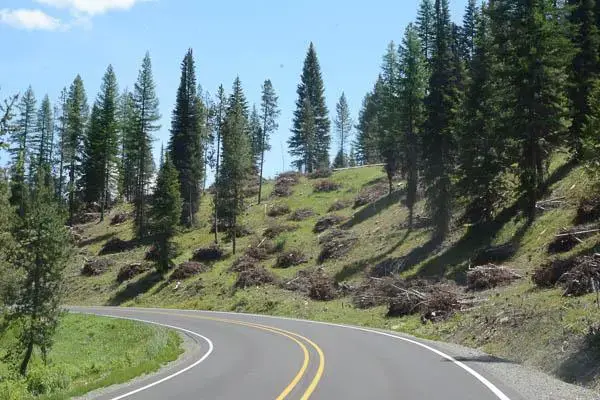
Thinning is essentially “gardening” the forest–selecting which trees are winners and which are losers. Photo by George Wuerthner.
A new study published in the journal Forest Ecology and Management “Significant mortality of old trees across a dry forest landscape, Oregon,” found that older larch and ponderosa pine are suffering increased death rates.

The main author, James Johnston, formerly at Oregon State University Forestry School, now at the University of Oregon’s Institute for Resilient Organizations, Communities, and Environments, found that between 2012 and 2023, a quarter of trees more than 300 years old in roadless areas he had previously studied had died. He attributes the decline to drought, insects and competition with other trees.
There’s nothing surprising in these findings, since eastern Oregon has suffered extreme drought for years. The climate is both drier and hotter—likely due to human-caused climate change.
What you do about this, if anything, is where there is debate.

Johnston suggests his research shows that we need “active management” to remove younger trees in order to protect old trees in dry forests of Eastern and Southern Oregon. Active management is the new code work for logging. His recommendations drive various forest collaboratives and Forest Service management on eastern Oregon forests.
I love these big trees myself, but the natural thinning of the forest from drought, insects and competition that is happening is analogous to a wolf pack that captures and kills old cows and bulls in an elk herd.
There are numerous problems with logging as a solution to the situation.

The first is that natural evolution is reorganizing the forest and selecting the trees that are better adapted to the on-going climate conditions. The logging/thinning of the forest that Johnson and others in the Forest Service propose is essentially forest gardening. In other words, the agency advocates selectively favoring some trees over others to preclude natural selection.
The second issue is that no one, including myself, can say which trees are best adapted to the on-doing and future climate conditions. As Johnston has correctly discerned, “Competition is one of the major driving forces behind Malheur’s losses”.

But competition is the basis for natural selection.
Thus, selective logging, even that done with good intentions, interferes with natural selection.

We can’t use historic forest conditions to dictate the future when the historic climate that created those forests no longer exists. The problem is that the ecological conditions that led to the forest stands found in eastern Oregon forests today were created hundreds of years ago when the climate was moister and cooler.
If one could anticipate a return to those cooler conditions, trying to “save” the older trees might make sense. However, there is nothing to indicate that climate warming is going to be reversed anytime soon.
Johnston tries to justify thinning/logging due to the fact that large old trees store a lot of carbon. However, at least in the media report, he insinuates that if they die suddenly, carbon storage would end. It does not. Dead trees continue to store carbon for decades, both in the bole and buried roots. The larger the tree, the longer it takes to rot, releasing its stored carbon.

Johnston noted in his study that a third of trees between 150 and 300 years old and a quarter of trees greater than 300 years old had died within the last 10 years. His alarmist conclusions ignore how forest ecosystems work.
Significant tree mortality is natural. Forests are not clocks. They have episodic mortality from high-severty fires, insect outbreaks, and drought. Periodic die offs in forest communities come in waves and are not “averaged” over hundreds of years.
The same older trees Johnson documents as dying likely got their start after some significant ecological disruption, like a major wildfire. These old trees were the survivors of competition that was allowed to proceed.
The other problem with Johnson’s solution is that logging is not benign. Besides removing carbon from the landscape, logging roads help to spread disease and weeds. Logging roads are a major source of sedimentation into streams, with negative impacts on aquatic ecosystems. And as I suggested, logging interferes with natural selection and evolution.

Rather than log the forest, we should allow evolution to proceed. The most crucial factor that wilderness and parks preserve is not old trees or any other entity, but ecological/evolutionary processes. We need to stop thinking of forest ecosystems as giant gardens where humans determine winners and losers
The post Should We Garden Our Forests? appeared first on CounterPunch.org.
